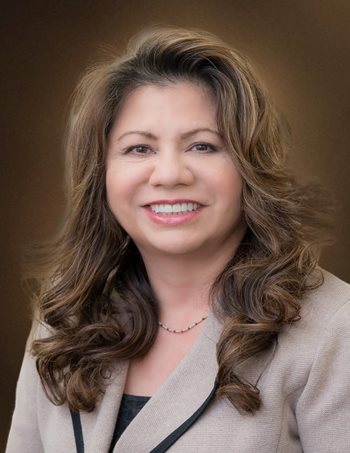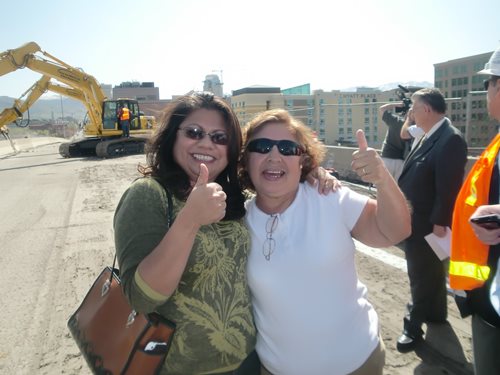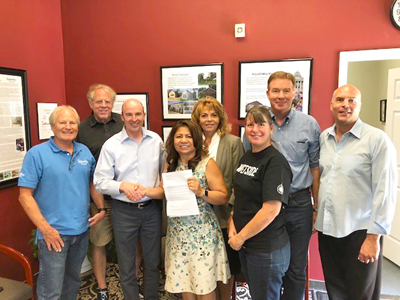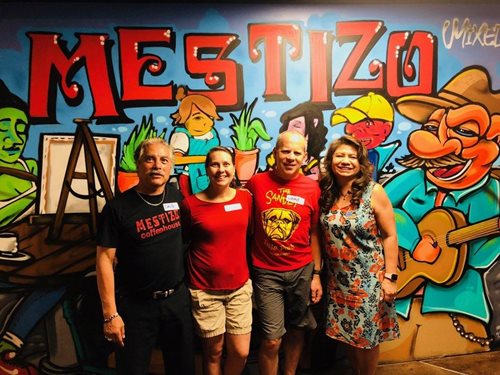Maria Garciaz came to NeighborWorks Salt Lake as a volunteer. She’d been working in juvenile court as a probation officer, sometimes with gang members, and the organization asked her to offer advice on a youth program to help teens build life skills. “I fell in love with the work,” she says. When YouthWorks finally came into being, she submitted an application to head the program. That was her path to community organizing.
 Garciaz, who became CEO of NeighborWorks Salt Lake when she was just 29, talked about her journey during Women’s History Month, a time to celebrate and study women in history and women making history.
Garciaz, who became CEO of NeighborWorks Salt Lake when she was just 29, talked about her journey during Women’s History Month, a time to celebrate and study women in history and women making history.
The middle of seven children, Garciaz grew up in a home that moved with the seasons. Her parents were migrant workers. Potatoes. Tomatoes. Cherries. They picked them all. Garciaz’s own first job was picking grapes in Lodi, California.
“We would follow the crops,” she says. In the fields, Garciaz would see women doing the organizing. They organized the picking in the early morning. They organized families at the end of the day. They made sure the children got an education. And that’s where her inspiration began.
When she was 14, Garciaz’s family stopped moving and purchased a home in Salt Lake City, after her father found a job as a chef. “I can’t tell you what a sense of relief it was to know I would be going to one school; we had been such a transient family,” Garciaz says. But staying in one place had some difficulties, especially in the white neighborhood where her family bought their home. The neighbors organized a petition, asking Garciaz and her family to move out; they thought a Latino family would devalue the price of their homes, the petition said.
Garciaz's family didn’t move. As a teenager, she was furious at the neighbors who signed. But her mother forgave them. In a year and a half, her mother won over the community, cooking traditional Mexican food, and inviting people into their home. “She didn’t see herself as an organizer,” Garciaz says. “But she knew that what often bought people to the table was food or dance or music. That was an important message for me.”
 An introvert, Garciaz would often sit and listen when she was in a crowded room. As CEO, she does the same – not that rooms have been crowded during the pandemic – always listening to what others say and allowing them to find their voice. “If I see a gap or a question not asked, that’s when I pipe in to help facilitate conversation,” she says. She finds herself facilitating more conversations as her organization and others focus on race, equity, diversity and inclusion (REDI). She remains the only woman of color at a community development organization in Utah; she knows of only two social service organizations with women of color at the helm.
An introvert, Garciaz would often sit and listen when she was in a crowded room. As CEO, she does the same – not that rooms have been crowded during the pandemic – always listening to what others say and allowing them to find their voice. “If I see a gap or a question not asked, that’s when I pipe in to help facilitate conversation,” she says. She finds herself facilitating more conversations as her organization and others focus on race, equity, diversity and inclusion (REDI). She remains the only woman of color at a community development organization in Utah; she knows of only two social service organizations with women of color at the helm.
But while there may not be many women of color at the top of organizations, the population in Salt Lake City has grown much more diverse than it was when Garciaz was younger. Now, 72% of the population in Salt Lake is white; the Latino population has grown to almost 22%.
The board of directors for NeighborWorks Salt Lake knew when they appointed Garciaz as CEO that communities of color would continue to grow, she says. “They realized that I came from the neighborhood I was working in. They saw a lot of potential in me and were committed to mentoring me to help me succeed.”
They also knew what she could do. When the YouthWorks program needed funding, Garciaz found a way to bring it in to keep the program running.
Everywhere she goes, Garciaz sees people she’s known from various parts of her career. Kids she worked with when she was a high school counselor or through YouthWorks. Parents who found homes through NeighborWorks Salt Lake. Earlier this year, the Salt Lake Tribune talked to the “kids” she had put together in a breakdancing program when she was a probation officer. She had listened to what they were saying and what they needed – and seen their passion – and provided them with an outlet, finding space for them to dance. The article called it Utah’s first hip-hop scene.
In 2002, Garciaz was invited to sit on the Salt Lake Winter Olympics organizing committee, which allowed her to make sure the people her organization served had the opportunity to participate as audience members or as volunteers.
(Tying those worlds together, breakdancing is now an Olympic sport. Garciaz, who witnessed the discipline and muscle control of breakdancing, welcomed the news.)
Rob Pedersen, who has been on the board of directors for NeighborWorks Salt Lake since 2005, says Garciaz’s combination of community focus and business acumen make her a strong leader. “It’s not a combination everybody has,” he says. “I’m a banker; a numbers guy, all about the balance sheet. She understands those numbers very well. But she also underst ands the need for community focus.”
ands the need for community focus.”
The organization has an annual Paint Your Heart Out event, where the community comes together to paint houses for people in need, such as older or disabled residents. Garciaz, he says, motivates and directs volunteers at that event, bringing in the story of the homeowner so that every person scraping the sides of the house, laying down drop cloths, and painting feels a connection. “Some leaders lead through fear or intimidation,” he says. Not Garciaz. “People respond to her because they love her,” he says. “You want to do good things for Maria and for the community.” She makes helping human, he says.
Garciaz had thought about other careers – and even tried them. “But community organizing found me,” she says. “I walked through doors people opened for me. When I see children struggling with what they want to do with their life, I say, ‘Walk through a door. See how it feels. If something clicks figure out how to pursue it.’”
NeighborWorks Salt Lake, where she has been for nearly 40 years, trained her. “Every day, I walk away learning something new either from staff or the board of directors or the partners we bring to the table.” She hopes her staff will do the same. She tells them: “We can lead from the front or lead from the side or lead from behind.” The goal is that no matter where you stand, you bring others along.
One way to do that is through NeighborWorks Salt Lake’s Westside Leadership Institute, which started in 2004 and has had more than 500 graduates. “That’s 500 community organizers doing amazing work in our area,” Garciaz says. The idea to have their own leadership institute came from volunteers who attended NeighborWorks America’s Community Leadership Institute.
“All through my life I saw people organizing,” says Garciaz, looking back. Sometimes, it was for good, like the women in the fields. Sometimes, it was for bad, like the neighbors who organized the petition. Garciaz’s own organizing, at the NeighborWorks organization that has been her home for four decades, has been for good. “You can be at front of the microphone or the back of the room,” Garciaz says. “It’s still organizing.”
03/29/2021

